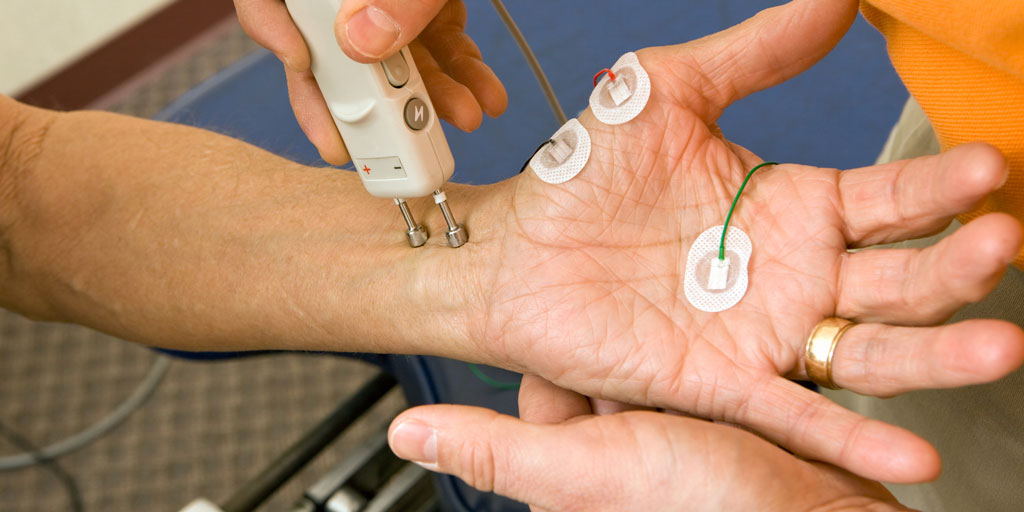
Simply Stated: What is Inclusion-Body Myositis?
By Jeanene Swanson | Friday, February 28, 2020
5 Second Summary
“Simply Stated” is a Quest column designed to explain some terms and basic facts about neuromuscular diseases.
Find more at Mdaquest.org/tag/simply-stated
Myopathy is a disease condition where muscle fibers do not function properly, resulting in muscular weakness. Inclusion-body myositis (IBM) is a type of inflammatory myopathy that is characterized by inflammation, weakness, and atrophy of the skeletal muscle. IBM develops in adulthood, usually after age 50. The symptoms and rate of progression vary from person to person.
IBM is characterized by both inflammation in muscles and muscle degeneration. Inflammatory (immune) cells invade the muscle tissue and concentrate between the muscle fibers in the form of inclusion bodies, which contain cellular material of dead tissue. When immune cells concentrate in muscles, the disease is called inclusion-body myositis — “myo” for muscle, “itis” for inflammation; thus, a myositis is an inflammatory muscle disease. Some genetic (inherited) forms of IBM don’t cause much inflammation, and this form is called inclusion-body myopathy (muscle disorder).
Symptoms of IBM
Some of the most common symptoms of IBM are progressive weakness of the legs, arms, fingers, and wrists. Some people also have weakness of the facial muscles (especially muscles of the eyes), or difficulty swallowing. Muscle cramping and pain are not common, but these have been seen in some patients.
The disease usually begins with the gradual onset of slowly progressing muscle weakness, for instance difficulty getting up from sitting in a chair, trouble gripping things, or difficulty swallowing. The majority of IBM patients experience weakness in the distal finger flexor muscles and weakness and atrophy in the quadriceps (knee flexors).
IBM progresses slowly over a period of years in most people. Most people need assistance with daily activities within 15 years of symptom onset, and some people will need to use a wheelchair.
Causes of IBM
The cause of IBM is not very well understood, but it probably involves the interaction of genetic, immune-related, and environmental factors. Some people may have a genetic predisposition to developing the disease, but the condition itself is not usually inherited.
Viral infection might trigger the disease. Some cases of myositis have followed infection with HIV, HTLV-1, and Coxsackie B viruses.
There are reports of myositis following exposure to certain drugs as well, including dasatinib (used to treat chronic myeloid leukemia), carticaine (a local anesthetic), and D-penicillamine (used to treat Wilson’s disease, rheumatoid arthritis, and various metal poisonings), among others.
Evolving research and treatment landscape
While there are no approved therapies to treat IBM, research is rapidly leading to increased understanding of the disease. Researchers supported by MDA are studying the underlying mechanisms that cause inflammatory myopathies. For instance, Ming Guo, MD, PhD, professor of Neurology and of Molecular and Medical Pharmacology at the University of California, Los Angeles, was awarded an MDA research grant to study IBM caused by mutations in the valosin-containing protein gene (VCP) in a fruit fly model and in human cells. In another research award, Thomas Lloyd, MD, PhD, associate professor of Neurology at Johns Hopkins University School of Medicine in Baltimore, will use MDA funds to study muscle regeneration in a mouse model of IBM.
Patients have much to hope for in terms of treatments on the horizon. Some potentially promising therapies that have been tested or are currently being tested in clinical trials include arimoclomol, an experimental drug that may help prevent certain proteins from clumping in muscle cells; follistatin gene therapy (follistatin is a muscle-building protein); and rapamycin (also known as sirolimus), an immune-suppressing drug that is used to prevent organ rejection in kidney transplant patients but may also prove to be a potential therapy for the treatment of IBM.
Next Steps and Useful Resources
- MDA’s Resource Center provides support, guidance, and resources for patients and families, including information about Inclusion Body Myositis (IBM), open clinical trials, and other services. Contact the MDA Resource Center at 1-833-ASK-MDA1 or ResourceCenter@mdausa.org
- For more information about the signs and symptoms of Inclusion Body Myositis (IBM), as well an explanation of the causes of disease, an in-depth overview can be found here.
- To learn more about clinical study opportunities in IBM, visit clinicaltrials.gov
- Stay up-to-date on Quest content! Subscribe to Quest Magazine and Newsletter.
Disclaimer: No content on this site should ever be used as a substitute for direct medical advice from your doctor or other qualified clinician.




